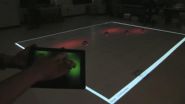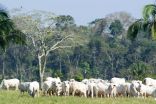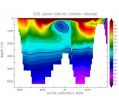(Press-News.org) CORVALLIS, Ore. - Researchers have discovered why many animal species can spend their whole lives outdoors with no apparent concern about high levels of solar exposure: they make their own sunscreen.
The findings, published today in the journal eLife by scientists from Oregon State University, found that many fish, amphibians, reptiles, and birds can naturally produce a compound called gadusol, which among other biologic activities provides protection from the ultraviolet, or sun-burning component of sunlight.
The researchers also believe that this ability may have been obtained through some prehistoric, natural genetic engineering.
The gene that provides the capability to produce gadusol is remarkably similar to one found in algae, which may have transferred it to vertebrate animals - and because it's so valuable, it's been retained and passed along for hundreds of millions of years of animal evolution.
"Humans and mammals don't have the ability to make this compound, but we've found that many other animal species do," said Taifo Mahmud, a professor in the OSU College of Pharmacy, and lead author on the research.
The genetic pathway that allows gadusol production is found in animals ranging from rainbow trout to the American alligator, green sea turtle and a farmyard chicken.
"The ability to make gadusol, which was first discovered in fish eggs, clearly has some evolutionary value to be found in so many species," Mahmud said. "We know it provides UV-B protection, it makes a pretty good sunscreen. But there may also be roles it plays as an antioxidant, in stress response, embryonic development and other functions."
In their study, the OSU researchers also found a way to naturally produce gadusol in high volumes using yeast. With continued research, it may be possible to develop gadusol as an ingredient for different types of sunscreen products, cosmetics or pharmaceutical products for humans.
A conceptual possibility, Mahmud said, is that ingestion of gadusol could provide humans a systemic sunscreen, as opposed to a cream or compound that has to be rubbed onto the skin.
The existence of gadusol had been known of in some bacteria, algae and other life forms, but it was believed that vertebrate animals could only obtain it from their diet. The ability to directly synthesize what is essentially a sunscreen may play an important role in animal evolution, and more work is needed to understand the importance of this compound in animal physiology and ecology, the researchers said.
INFORMATION:
Collaborators on this research were Robert Tanguay and Alan Bakalinsky from the OSU College of Agricultural Sciences and Andrew Karplus from the OSU College of Science. The study was supported by the OSU College of Pharmacy and the National Institutes of Health.
Using a smart tablet and a red beam of light, Georgia Institute of Technology researchers have created a system that allows people to control a fleet of robots with the swipe of a finger. A person taps the tablet to control where the beam of light appears on a floor. The swarm robots then roll toward the illumination, constantly communicating with each other and deciding how to evenly cover the lit area. When the person swipes the tablet to drag the light across the floor, the robots follow. If the operator puts two fingers in different locations on the tablet, the machines ...
Diet exerts a major impact on health and ageing. The nervous system plays an important role in this process but, thus far, how food signals are interpreted by the nervous system has been a mystery. This is an important question because the perception of food by the nervous system impacts not just ageing, but also other processes associated with health and disease, including metabolism, reproduction, and development.
A new study published in eLife by researchers from the MRC Centre for Developmental Neurobiology (MRC CDN) at the Institute of Psychiatry, Psychology & Neuroscience ...
To measure distances in the Universe, astronomers use Cepheids, a family of variable stars whose luminosity varies with time. Their role as distance calibrators has brought them attention from researchers for more than a century. While it was thought that nearly everything was known about the prototype of Cepheids, named Delta Cephei, a team of researchers at the University of Geneva (UNIGE), the Johns Hopkins University, and the European Space Agency (ESA), have now discovered that this star is not alone, but that it has a hidden companion. A revelation published in The ...
MADISON, Wis. -- Expansion of cattle pastures has led to the destruction of huge swaths of rain forest in Brazil, home to the world's largest herd of commercial beef cattle. But a new study led by the University of Wisconsin-Madison's Holly Gibbs shows that market-driven "zero deforestation agreements" have dramatically influenced the behavior of ranchers and the slaughterhouses to which they sell.
Publishing today [May 12, 2015] in the journal Conservation Letters, the research team - including other UW-Madison scientists, the National Wildlife Federation, and IMAZON ...
Scientists from Oregon State University have discovered that fish can produce their own sunscreen. They have copied the method used by fish for potential use in humans.
In the study published in the journal eLife, scientists found that zebrafish are able to produce a chemical called gadusol that protects against UV radiation. They successfully reproduced the method that zebrafish use by expressing the relevant genes in yeast. The findings open the door to large-scale production of gadusol for sunscreen and as an antioxidant in pharmaceuticals.
"The fact that the compound ...
Extremely high levels of cardiovascular risk factors have been found in people with established psychosis, with central obesity evident in over 80 per cent of participants, in a study by researchers from the NIHR Biomedical Research Centre at the South London and Maudsley NHS Foundation Trust (SLaM) and King's College London.
In the largest study of its kind in the UK, drawing on a sample of more than 400 outpatients with psychosis, it was discovered that nearly half of the sample were obese (48 per cent), with a body mass index (BMI) of 30 or more. Additionally, nearly ...
Around 55 million years ago, an abrupt global warming event triggered a highly corrosive deep-water current to flow through the North Atlantic Ocean. The origin of this corrosive water has puzzled scientists for a decade.
Now, researchers have discovered this current and how it formed. The findings, published today in Nature Geoscience, also have profound implications for the sensitivity of our current climate to carbon dioxide emissions.
The researchers explored the acidification of the ocean that occurred during a period known as the Paleocene Eocene Thermal Maximum ...
A low platelet count can occur as the result of a variety of medical conditions and as a medication side effect. Platelet transfusion is often required for individuals with a critically low platelet level. Currently, the primary source of platelets is volunteer donors. Unfortunately, donated platelets have an extremely short shelf life and can be in limited supply. A new study in the Journal of Clinical Investigation reports on a method to generate progenitor cells from murine embryonic stems that are able to produce a large number of functional platelets. Mitchell Weiss ...
Bacterial meningitis is a life-threating infection of the central nervous system. Group B Streptococcus (GBS) is the leading cause of meningitis in newborn babies and can cause severe complications in those that survive the infection. GBS must cross the blood-brain-barrier (BBB) to cause disease but it is not clear how these organisms breach this barrier. A new study in the Journal of Clinical Investigation identifies a pathway that is induced by GBS and disrupts junctions between cells. Kelly Doran and colleagues at San Diego State University determined that GBS induces ...
PROSSER, Wash. - Washington wine grape vineyards experimenting with sustainable pest management systems are seeing an unexpected benefit: an increase in butterflies.
Over the years, loss in natural habitat has seen the decline in numbers of around 50 species of butterflies in eastern Washington. But in a recent Washington State University study published in the June issue of the Journal of Insect Conservation, researchers found that vineyards that create nearby natural habitats have three times the number of butterfly species and four times more butterflies than conventional ...



